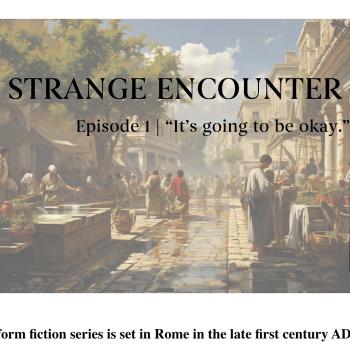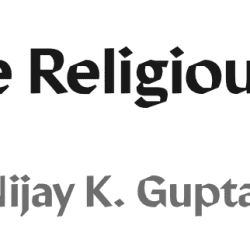In the earlier part, I simply introduced the commentary by Fee. Now I will press on to comment on the content and theological perspective of Fee’s excellent commentary.
On introductory issues, Fee has little to say. He favors the Southern Galatians view just slightly (with the mentioning of Barnabas being the tipping factor). More controversially, Fee places Galatians between the writing of 2 Cor. and Romans – for a number of reasons, but it includes the close relationship between Romans and Galatians. He does not expand upon all the reasons, but he has taken this approach in his earlier works and I am sure he offers some explanation there. In the end, he explains that such differences of opinion on the dating and the location of the readers does not greatly affect the interpretation of the epistle.
One thing to take notice of, in Fee’s method of interpretation, is his eye for the word-order of the Greek sentences. For example, in the salutation he sees the order of ‘grace and peace’ (1.3) to be purposeful in order – as peace results from grace. Fee is attributing to Paul, here, a high level of intentionality even in perfunctory sorts of parts of the letter. I have no problem with this assumption and he makes some interesting points, though it is difficult to know for sure.
I think an exegetical conundrum in Galatians is the actual point of the personal narrative in chs. 1-2. Why does Paul spend so much time discussing where he has been, who he has been with, and all that? Fee’s perspective is helpful:
His point in [1.13-24] was to capitalize on what his detractors saw as a defect, namely, that they came from Jerusalem but Paul had not. But what they saw as a defect Paul saw as to his great advantage. His gospel came directly from Christ and therefore had nothing to do with “men,” either in terms of source of approval’(55)
Another issue that Fee touches upon is how to translate and interpret the challenging Greek word sarx. He aptly explains that, for Paul, being ‘in the flesh’ means: ‘to live according to the values and desires of life in the present age that stand in absolute contradiction to God and his ways’ (108).
Now the question you have been waiting for – what about the New Perspective and the question of the law? Fee seems quite supportive of the fundamental convictions behind the New Perspective on Paul and the issues in Galatia.
‘At issue…is not how people gain their salvation, but whether “saved people” must also adhere to the law’ (81); ‘the primary issue of this letter is not “justification by faith,” but Gentile inclusion as Abraham’s – and therefore God’s – true children and thus rightful heirs of the final inheritance.’ (151)
He also seems quite close to the views of J.D.G. Dunn when he highlights the boundary-marking nature of the law. Here he is insistent that the law was given for social and moral reasons, rather than soteriological ones (see 189).
One of the issues that Fee discusses is the perennial problem of translating dikaioo into English.
‘interestingly, the word “absolve,” in the sense of “to grant pardon for” would seem to come closest to [an English equivalent], but it is a word Protestants are loathe to use because of what they perceive to be abuses in Roman Catholic use of the word’ (83)
He finds ‘acquit’ to be inappropriate as it means no verdict of guilt is involved. In Fee’s mind, this kind of thinking can lead to problems. Sin is there, guilt is there, but it has been pardoned, not treated as non-existent in the first place.
On the matter of pistis christou – ‘faith of Christ’ – Fee argues for the objective genitive (‘faith in Christ’). One point he makes is that Mark 11.22, exete pistin theou, would have clearly meant ‘have faith in Christ’, not ‘have the faith of Christ’.
One of the more interesting discussions in Fee’s commentary is his treatment of Gal. 3.12 with the quote from Lev. 18.5. Here, when some say the issue is ecclesiological and others that it is soteriological, Fee argues that it is primary eschatological (this is my paraphrasing of his views). If one is to choose to carry out the works of Torah, then one is choosing a life that involves going back to an outdated paradigm of religious life. Moreover, one is choosing this paradigm that was never intended to save or to make one righteous.
Fee underscores Paul’s point that one cannot pick and choose which laws to follow and which to ignore for the Galatians. It is all or nothing. One cannot mix and match ‘faith in Christ’ elements with ‘works of law’ elements. If one decides to take on parts of the law – they decide to carry out the whole thing (thus Gal. 3.12). He follows up with an important point: ‘The plain assumption in all of this, one should note at the end, is that people can do “the righteousness” found in the law, understood as observable behavior…The curse is that they must do so, and thus they are excluded from Christ’ (118). Well said, Gordon.
A serious concern that one could issue with Fee’s intepretation is that it could seem to reject the importance of the OT altogether. This could be fuel for supporting a kind of Marcionism. But, Fee makes an important clarification. The law is still useful as a reminder of God’s desire of morality and virtue, but the law’s role of ‘hemming in human conduct because of trangressions’ has been made obsolete by the advent and endowment of the Spirit. The Spirit is able to bring about the kind of righteousness God desires (a function not available to the law).
While we are on the topic of ethics, Fee has an excellent discussion of the moral discourses in the last couple of chapters of Galatians. A nice pithy quote, though, comes from his summary of Pauline ethics:
‘God’s glory is their purpose, the Spirit is their power, love is the principle, and Christ is the pattern’ (232)
I will end with probably one of the most perplexing issues in Galatians – Paul’s use of OT imagery and, especially, the discourse on Hagar and Sarah. Is it reasoned allegory? Some kind of typology? What do we do with it? Can be learn how do to that? What Paul just making it up as he went along? With respect to Gal. 4.21-5.12, Fee has these wise words:
‘Paul was inspired by the Spirit in ways that we are not; and this passage was not written to give us an example of “how to do Scripture” (197) ‘we simply do not know enough about their situation to know how much, if any, of this paragraph is in direct response to what was being argued by the agitators themselves’ (197)











